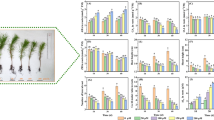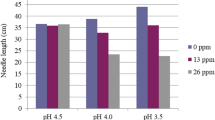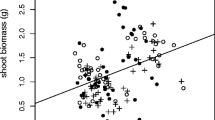Abstract
Trees in general are very tolerant of aluminum (Al, mainly Al3+ at pH ≦ 5.0), and the small effects seen in the contaminated soils may mislead people that the contamination is unimportant. The key point of this study was to characterize the Al toxicity for Masson pine (Pinus massoniana Lamb). The objectives were to discover the specific eco-physiological relationship between pine root growth and rhizosphere Al, and to investigate the Al effects on the root-released compounds of sugars, organic acids, amino acids, secondary metabolites, as well as rhizosphere pH and endogenous hormones. Masson pine seedlings were cultivated on a hydroponic setup. Through comprehensive dose-gradient experiments, the Al-triggered root-released compounds were determined by chromatography or spectroscopy. This study gives an important evidence of the Al-toxicity effects on the composition of root-released compounds and the root growth of Masson pine. Results showed that higher rhizospheric Al at pH 4.5 might contribute to increased release of glucose, and also could accelerate the release of oxalic acid and malic acid. The total of secreted amino acids were correlated with the rhizosphere Al. Zero additional Al induced no rhizosphere pH elevation, but Al-induced rhizosphere acidification (pH from 4.50 to 4.22) was observed et al. 100 µM. Greater additions of Al (> 300 µM) suppressed the rhizosphere acidification at pH 3.92. Added Al had a negative effect on the dry weight of pine roots, but an opposite effect on Al accumulated in the roots was observed. Four endogenous hormones were also determined in the pine roots. Gibberellic acid (GA3) decreased, whereas abscisic acid (ABA) simultaneously increased with the addition of Al. Their inflexional concentrations were most frequently observed et al. 100 µM, which might be the threshold of Al toxicity for Masson pine. The secondary metabolites assayed have been studied in relation to the rhizospheric Al. The rhizosphere Al species at low pH could trigger pine roots to release the sugars (glucose, fructose + aldose), organic acids (oxalic acid, and malic acid), amino acids, secondary metabolites, and endogenous hormones. Meanwhile exposure of growing root apices to toxic Al concentrations inhibited the growth of pine roots. This is an extensive study, which can help understanding the toxicity of Al to this important pioneer species of acid forest soils in south China.
Graphical abstract





Similar content being viewed by others
References
Gomez-Zepeda D, Frausto M, Nájera-González H-R, Herrera-Estrella L, Ordaz-Ortiz J-J (2021) Mass spectrometry-based quantification and spatial localization of small organic acid exudates in plant roots under phosphorus deficiency and aluminum toxicity. Plant J 106:1791–1806
Haruta M, Constabel CP (2003) Rapid alkalinization factors in poplar cell cultures. Peptide isolation, cDNA cloning, and differential expression in leaves and methyl jasmonate-treated cells. Plant Physiol 131:814–823
Hirano Y, Frey B, Brunner I (2012) Contrasting reactions of roots of two coniferous tree species to aluminum stress. Environ Exp Bot 77:12–18
Imadi SR, Waseem S, Kazi AG, Azooz MM, Ahmad P (2016) Aluminum toxicity in plants: an overview. Plant Metal Interact 1–20
Kopittke PM, Moore KL, Lombi E, Gianoncelli A, Ferguson BJ, Blamey FPC, Menzies NW, Nicholson TM, McKenna BA, Wang P, Gresshoff PM, Kourousias G, Webb RI, Green K, Tollenaere A (2015) Identification of the primary lesion of toxic aluminum in plant roots. Plant Physiol 167:1402–1411
Lan T, You JF, Kong LN, Yu M, Liu MH, Yang ZM (2016) The interaction of salicylic acid and Ca2+ alleviates aluminum toxicity in soybean (Glycine max L.). Plant Physiol Bioch 98:146–154
Liang C, Piñeros MA, Tian J, Yao Z, Sun L, Liu J, Shaff J, Coluccio A, Kochian LV, Liao H (2013) Low pH, aluminum, and phosphorus coordinately regulate malate exudation through GmALMT1 to improve soybean adaptation to acid soils. Plant Physiol 161:1347–1361
Liu XW, Lin Y, Liu D, Wang CX, Zhao ZQ, Cui XM, Liu Y, Yang Y (2016) MAPK-mediated auxin signal transduction pathways regulate the malic acid secretion under aluminum stress in wheat (Triticum aestivum L.). Sci Rep 7:1620
Ma YL, Zhu M, Shabala L, Zhou MX, Shabala S (2016) Conditioning of roots with hypoxia increases aluminum and acid stress tolerance by mitigating activation of K+ efflux channels by ROS in barley: insights into cross-tolerance mechanisms. Plant Cell Physiol 57(1):160–173
Minorsky PV (2019) Vacuolar H+-ATPase regulates Al resistance. Plant Physiol 181:382
Martins N, Gonҫalves S, Andrade PB, Valentão P, Romano A (2013) Changes on organic acid secretion and accumulation in Plantago almogravensis Franco and Plantago algarbiensis Samp. under aluminum stress. Plant Sci 198:1–6
Pandey P, Srivastava RK, Dubey RS (2013) Salicylic acid alleviates aluminum toxicity in rice seedlings better than magnesium and calcium by reducing aluminum uptake, suppressing oxidative damage and increasing antioxidative defense. Ecotoxicology 22:656–670
Piñeros MA, Shaff JE, Manslank HS, Carvalho Alves VM, Kochian LV (2005) Aluminum resistance in maize cannot be solely explained by root organic acid exudation. A comparative physiological study. Plant Physiol 137:231–241
Ramesh SA, Kamran M, Sullivan W, Chirkova L, Okamoto M, Degryse F, McLaughlin M, Gilliham M, Tyerman SD (2018) Aluminum-activated malate transporters can facilitate GABA transport. Plant Cell 30:1147–1164
Rehmus A, Bigalke M, Valarezo C, Castillo JM, Wilcke W (2014) Aluminum toxicity to tropical montane forest tree seedlings in southern Ecuador: response of biomass and plant morphology to elevated Al concentrations. Plant Soil 382:301–315
Riaz M, Yan L, Wu XW, Hussain S, Aziz O, Jiang CC (2018) Mechanisms of organic acids and boron induced tolerance of aluminum toxicity: a review. Ecotoxicol Environ Saf 165:25–35
Tan JK, Kong FX, Cao HS, Yu Y, Han XB (2005) Effects of acid precipitation and aluminum on carbohydrate metabolism in mycorrhizae of Pinus massioniana. Bull Environ Contam Toxicol 74:614–622
Tikhomiroff C, Jolicoeur M (2002) Screening of Catharanthus roseus secondary metabolites by high-performance liquid chromatography. J Chromatogr A 955:87–93
van Schöll L, Keltjens WG, Hoffland E, Breemen NV (2004) Aluminium concentration versus the base cation to aluminium ratio as predictors for aluminium toxicity in Pinus sylvestris and Picea abies seedlings. For Ecol Manage 195:301–309
Vitorello VA, Capaldi FR, Stefanuto VA (2005) Recent advances in aluminum toxicity and resistance in high plants. Brazilian J Plant Physiol 17:129–143
Wang P, Bi SP, Ma LP, Han WY (2006) Aluminum tolerance of two wheat cultivars (Brevor and Atlas 66) in relation to their rhizosphere pH and organic acids exuded from roots. J Agric Food Chem 54:10033–10039
Wang P, Zhou S, Zhang M (2020) Occurrence of endogenous hormones in the roots of Masson pine (Pinus massoniana Lamb.) seedlings subjected to aluminum stress under the influence of acid deposition. Plant Growth Regul 92:43–52
Wang SL, Chen LW, Fan CQ, Wang P (2016) Determination of abscisic acid, gibberellic acid, indole-3-acetic acid, and zeatin riboside in Masson pine (Pinus massoniana L.) by accelerated solvent extraction and high-performance liquid chromatography-tandem mass spectrometry. Anal Lett 49(13):1986–1996
Wang SL, Fan CQ, Wang P (2015a) Determination of ultra-trace organic acids in Masson pine (Pinus massoniana L.) by accelerated solvent extraction and liquid chromatography–tandem mass spectrometry. J Chromatogr B 981–982:1–8
Wang SL, Wang P, Fan CQ (2015b) Distribution of aluminum fractionation in the acidic rhizosphere soils of Masson pine (Pinus massoniana L.). Commun Soil Sci Plan 46:2033–2050
Wang SL, Wang P, Fan CQ, Xu H (2012) Phytoavailability and speciation of aluminum carried by total suspended particulates (TSP) to Masson pine (Pinus massoniana L.). Atmos Environ 47:358–364
Wenzl P, Chaves AL, Patiño GM, Mayer JE, Rao IM (2002) Aluminum stress stimulates the accumulation of organic acids in root apices of Brachiaria species. J Plant Nutr Soil Sci 165:582–588
Wu RJ, Zhuang J, Huang J, Chen WP (2009) Responses and resistance mechanism of Pinus massoniana under the stresses of simulated acid rain and aluminum. Scientia Silvae Sinicae 45:22–29
Yan L, Riaz M, Liu Y, Zeng Y, Jiang CC (2019) Aluminum toxicity could be mitigated with boron by altering the metabolic patterns of amino acids and carbohydrates rather than organic acids in trifoliate orange. Tree Physiol 39:1572–1582
Yang JL, Fan W, Zheng SJ (2019) Mechanisms and regulation of aluminum-induced secretion of organic acid anions from plant roots. Biomed Biotechnol 20(6):513–527
Yang M, Tan L, Xu YY, Zhao YH, Cheng F, Ye SM, Jiang WX (2015) Effect of low pH and aluminum toxicity on the photosynthetic characteristics of different fast-growing Eucalyptus vegetatively propagated clones. PLoS ONE 10:e0130963
Yang TY, Qi YP, Huang HY, Wu FL, Huang WT, Deng CL, Yang LT, Chen LS (2020) Interactive effects of pH and aluminum on the secretion of organic acid anions by roots and related metabolic factors in Citrus sinensis roots and leaves. Environ Pollut 262:114303
Yang ZB, He C, Ma Y, Herde M, Ding Z (2017) Jasmonic acid enhances Al-induced root growth inhibition. Plant Physiol 173:1420–1433
Yao HY, Zhang SN, Zhou WY, Liu YM, Liu YM, Wu YY (2020) The effects of exogenous malic acid in relieving aluminum toxicity in Pinus massoniana. Int J Phytoremediat 22(6):669–678
Zhang F, Yan X, Han X, Tang R, Chu M, Yang Y, Yang YH, Zhao F, Fu A, Luan S, Lan W (2019a) A defective vacuolar proton pump enhances aluminum tolerance by reducing vacuole sequestration of organic acids. Plant Physiol 181:743–761
Zhang HH, Jiang Z, Qin R, Zhang HN, Zou JH, Jiang WS, Liu DH (2014) Accumulation and cellular toxicity of aluminum in seedling of Pinus massoniana. BMC Plant Biol 14:264
Zhang M, Lu X, Li C, Zhang B, Zhang C, Zhang XS, Ding Z (2018) Auxin efflux carrier ZmPGP1 mediates root growth inhibition under aluminum stress. Plant Physiol 177:819–832
Zhang X, Cui Y, Yu M, Su B, Gong W, Baluˇ ska F, Komis G, Šamaj J, Shan X, Lin J (2019b) Phosphorylation-mediated dynamics of nitrate transceptor NRT1.1 regulate auxin flux and nitrate signaling in lateral root growth. Plant Physiol 181:480–498
Ren JH, Yang XX, Zhang N, Feng L, Ma CY, Wang YL, Yang ZP, Zhao J (2022) Melatonin alleviates aluminum-induced growth inhibition by modulating carbon and nitrogen metabolism, and reestablishing redox homeostasis in Zea mays L. J Hazard Mater 423:127159
Acknowledgements
This work was financially supported by the Natural Science Foundation of China (30771696; 31270680). We thank the many graduate students for their assistance with this work.
Funding
The funded was provided Natural Science Foundation of China, Grant No. (30771696). Natural Science Foundation of Tianjin Municipal Science and Technology Commission (CN), Grant No (31270680).
Author information
Authors and Affiliations
Corresponding author
Ethics declarations
Conflict of interest
No potential conflict of interest was reported by the authors.
Additional information
Communicated by Feibo Wu.
Publisher's Note
Springer Nature remains neutral with regard to jurisdictional claims in published maps and institutional affiliations.
Supplementary Information
Below is the link to the electronic supplementary material.
Rights and permissions
About this article
Cite this article
Wang, P., Zhou, S., Li, A. et al. Influence of aluminum at low pH on the rhizosphere processes of Masson pine (Pinus massoniana Lamb). Plant Growth Regul 97, 499–510 (2022). https://doi.org/10.1007/s10725-022-00816-x
Received:
Accepted:
Published:
Issue Date:
DOI: https://doi.org/10.1007/s10725-022-00816-x




